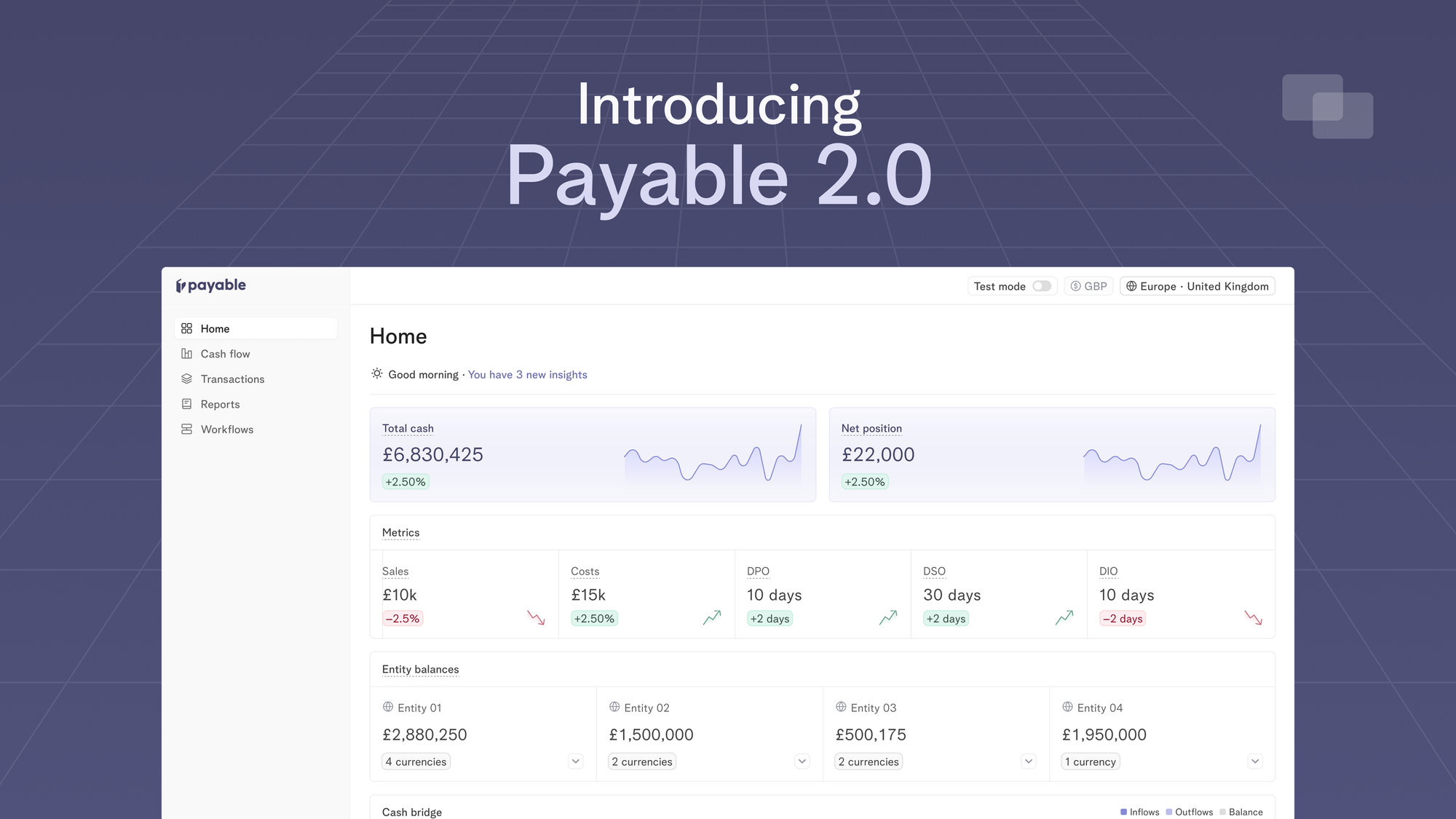
Accounts receivable, or A/R for short, is the core pillar of financial management, ensuring that businesses can navigate their liquidity and cash flow. In its simplest form, accounts receivable represent the money owed to a company by its customers. Inefficient accounts receivable management can often become a significant bottleneck for businesses ability to scale.
Understanding accounts receivable management process
Let’s face it, manually logging into multiple bank portals, downloading the data and stitching it all together in spreadsheets is time consuming, error prone and simply not scalable. From the manual work of tracking invoices and payments, to the never-ending battle of minimising days sales outstanding (DSO), finance teams undoubtedly have their work cut out for them.
When your business sells a product or service on credit, it creates an 'account receivable' in your internal ledger. This account is a promise from your customer to pay you a certain amount at a future date. Depending on the size of your company and business model, your billing, invoicing and payment collection will differ, however, the process usually looks like this:
- Your company delivers a product or service to a customer.
Sales are tracked and recorded in your internal ledger. - An invoice is issued to the customer, detailing the terms of payment.
Invoicing and billing are managed by your accounting platform or specialised payment service provider (PSP). - The customer, in line with the invoice terms, makes a payment.
Payments are collected using any of the payment methods - cards, direct debit, BNPL, manual bank transfer and others. - Your company records the payment and reconciles it with the outstanding invoice.
Funds are tracked in your banking portal or by PSP and reconciled regularly either using spreadsheets, your accounting software or combination of either of these options.
Simple, right? Well, as any finance leader knows, the devil is often in the details.
Key challenges with accounts receivable management
Finance team’s goal is to efficiently manage company's financial resources in order to achieve its goals and objectives - usually maximising profits while minimising costs. A/R play a crucial role in driving efficiency, but is often blocked by the following challenges in accounts receivable management process:
- Late payments: Customers don't always pay their invoices on time. Reported 87% of businesses are paid after the invoice due date. This directly impacts company's cash flow, liquidity and even its ability to operate smoothly.
- Lack of payment visibility: Understanding when payments are expected is vital in predicting cash flow and proactively managing company's finances.
- Outdated processes: Keeping track of invoices, payments, and reconciliations can be an all-consuming task that diverts resources from other core business functions. Finance teams in mid-size businesses spend 14 hours a week chasing overdue invoices. Without an automated system, tracking unpaid invoices can become a time-consuming task.
- Fragmented payments stack: If you receive payments from multiple payment methods that already complicates your accounts receivable management process. Keeping track of all the incoming payments on spreadsheets is simply not scalable, nor sustainable. According to a PWC report 75% of finance teams time is spent on stitching together fragmented data and insights, leading to less time spent on proactive cash flow management.
- Errors and omissions: Finally, errors and omissions are simply a failure of recording correct items in the general ledger. Whether due to human error or system glitches, they can cause discrepancies that take time and effort to sort out.
Now imagine a world, where isolated spreadsheets, manual invoice chasing and dunning are a thing of the past, and your finance team can focus on work that actually makes a difference to your bottom line. That is the power of accounts receivable automation.
The benefits of accounts receivable automation
Each step of the A/R process has some manual input that requires your finance team’s attention. As the company grows and the payment and invoicing volumes increase, so does the challenge of managing A/R at scale if you only relied on spreadsheets and good faith. Therefore, automating A/R from start to finish will deliver efficiencies across the entire process, here’s how:
- Improved cash flow management: A/R automation provides real-time visibility into your receivables, allowing you to make informed decisions about when to collect payments and when to extend credit. Innovation like Open banking helps businesses share their financial data in real-time, giving more control and transparency on their cash flow movement across all bank accounts.
- Efficiency: A/R automation is all about reducing time spent on manual tasks and eliminating human error. Everything from invoice generation, manual reconciliation to payment reminders can be automated, freeing up your team to focus on more strategic tasks.
- Reduced costs: By reducing manual tasks, you're not only saving time, but you're also saving money. Automation can significantly reduce the cost of managing accounts receivable, contributing to the overall financial health of your business.
- Reduced DSO: By automating your receivables management process, you can reduce the days sales outstanding (DSO). This, in turn, keeps your cash flow healthy and in control of reinvesting more resources to drive growth.
- Improved customer experience: Using gentle and considerate reminders can be less intrusive and more pleasant than repeated phone calls. Plus, your customers will appreciate the ease of payment options available to settle their invoice.
- Advanced reporting and analytics: By automating your accounts receivable process, you can gain real-time insights into your financial performance and make informed decisions about your business. Using manual processes and spreadsheets do not scale and can’t offer the insights needed to identify trends, opportunities, and potential risks affecting your business.
Key features of accounts receivable automation solutions
Real-time payment tracking and reconciliation
A/R automation provides real-time visibility on payment statuses, including when they are received, processed, and settled. Businesses that are managing large volumes of payments and invoices that don’t have optimal accounts receivable management processes are particularly exposed to human errors that require manual intervention. With automation, transactions can be tracked and reconciled in real-time, ensuring that your records are always up-to-date and accurate across all your billing, invoicing and payment providers.
Furthermore, real-time payment tracking and reconciliation can help improve your customer relationships by providing them with timely updates on the status of their payments. This helps build trust and confidence in your business, which can lead to repeat business and referrals.
Seamless integration and interoperability with existing systems
When evaluating accounts receivables automation tools, it’s important to ensure they seamlessly integrate with your existing tech and payments stack. Having a direct integration with your accounting and ERP systems will ensure that all tools use the same source of truth and will keep records accurate across all platforms.
For example, when a payment is received, you can automatically reconcile that transaction and update your accounting software or ERP, eliminating the need for your employees to manually enter the data and reducing the risk, errors and inconsistencies in your financial records.
Advanced reporting and analytics
The goal of accounts receivable automation is to ensure financial accuracy and enable your time to focus on proactive cash flow management. With reporting and analytics, your finance team has a real-time view on your business's financial performance. It gives you access to customisable reports, centralised dashboards, and simple charts and graphs to identify trends in your business's financial performance, allowing you to make better data-driven decisions.
For example, you can identify which customers are consistently late with their payments, and take steps to address this issue. Or you can spot opportunities for growth based on product lines and market data.
Choosing the right accounts receivable management solution
- Understand your current process
Your first step should be assessing your business's unique needs and goals. The more complex your business structure, the faster you will look for solutions to automate manual tasks. Businesses with multiple entities and currencies will struggle to keep up with their receivables by only relying on spreadsheets or accounting software. Doing a thorough audit on your current A/R process will give you a clear picture of what other requirements you need to look out for. - Choose the right vendor
As part of the vendor selection process, look out for solutions that don’t rely on outdated legacy systems and can easily integrate with your current tech stack. Make sure they are a cloud-based and can integrate in days rather than months or years. Another sign to look out for is bank connectivity with Open banking APIs, a clear and intuitive interface and a roadmap that can support your future needs for cash management, accounts payable (A/P) and treasury. - Measure ROI and improvement
Once you have made your selection don’t forget to track ROI and improvements across the team. It’s worth setting your KPIs and benchmarks before introducing the vendor to ensure you can outline and evidence your business case. The right automation partner will drive cost and time savings ultimately keeping your team more efficient without adding extra headcount.
In conclusion
In the digital age, automation is no longer an option, but a necessity. By automating the accounts receivable process, finance teams can increase efficiency, reduce errors, and free up valuable time and resources. It's a smart and strategic move that offers long-term payoff.
Payable automates accounts receivable and treasury operations across all your corporate bank accounts. Our suite of products help finance and treasury teams reduce time and effort spent on tracking invoices, reconciling transactions, and chasing overdue payments.
Alvaro Noriega, Head of Finance at Payflow says: “With Payable we have automated at least 40% of the manual work we were doing.”

Announcements
Introducing Payable 2.0 - one platform to optimise working capital, make fast liquidity decisions and move your cash metrics in real-time
13 Apr 2024
Today, we’re excited to launch Payable 2.0 which is our evolution to a more connected, intelligent and automated platform for finance teams to track their cash flows in real-time.

Cash Management
Mastering 13-week direct cash flow forecasts
26 Mar 2024
Knowing how your cash flow will behave in the future is crucial for the success and sustainability of any company. One way to achieve this is through the use of a 13-week direct cash flow forecast, which provides a detailed projection of a company's inflows and outflows over a specific time period.
